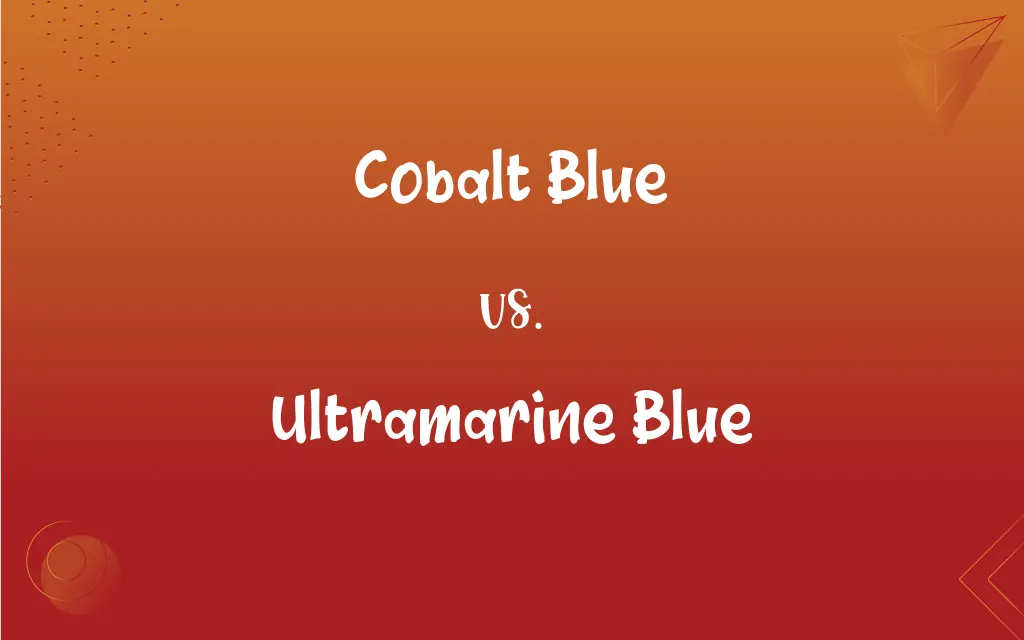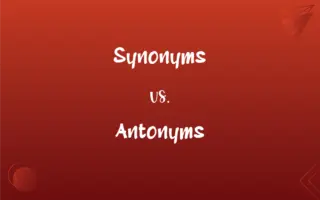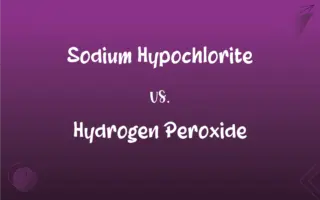Cobalt Blue vs. Ultramarine Blue: What's the Difference?
Edited by Aimie Carlson || By Harlon Moss || Published on November 11, 2024
Cobalt blue is a vivid blue pigment made from cobalt salts, while ultramarine blue, originally from lapis lazuli, is a deeper, slightly violet blue.

Key Differences
Cobalt blue is a chemical pigment created using cobalt salts. It has a bright, slightly greenish-blue hue that is very stable and lightfast, making it a favorite among artists for centuries. Ultramarine blue, on the other hand, is a pigment with a rich history, originally made from the mineral lapis lazuli. It possesses a deep blue color with a hint of violet, historically valued for its brilliance and depth of color.
Cobalt blue offers a cooler, more subdued shade of blue compared to ultramarine blue. Its clarity and brightness have made it a popular choice in both art and design, capable of producing vibrant skies and waters. Ultramarine blue, known for its warmth and depth, tends towards a more violet tone, making it ideal for shadows and depicting the natural world.
The production of cobalt blue involves the synthesis of cobalt salts with alumina at high temperatures, a relatively modern method discovered in the early 19th century. Ultramarine blue's traditional method of production from lapis lazuli is much older and was more complex and costly, which once made it more valuable than gold.
In terms of application, cobalt blue is versatile, mixing well with other colors without overpowering them. It is used in various mediums, from oil paints to ceramics. Ultramarine blue's intense color and tendency to granulate in watercolors make it unique, offering texture and depth to paintings.
Cobalt blue's lightfastness and stability under sunlight make it suitable for outdoor uses, such as in glazes and glass. Ultramarine blue, while also stable, is often chosen for its ability to create a wide range of tones when mixed, from delicate lavenders to deep indigos, enriching artwork with its versatility.
ADVERTISEMENT
Comparison Chart
Composition
Made from cobalt salts
Originally from lapis lazuli
Color Tone
Bright, slightly greenish-blue
Deep blue with a hint of violet
History
Discovered in the 19th century
Ancient, valued since antiquity
Mixing Properties
Mixes without overpowering
Can dominate mixes with its intensity
Application
Versatile in art and design
Preferred for depth and texture in paintings
ADVERTISEMENT
Cobalt Blue and Ultramarine Blue Definitions
Cobalt Blue
A bright blue pigment made from cobalt.
The artist chose cobalt blue for the sky to make it pop.
Ultramarine Blue
A pigment that adds warmth and texture to artworks.
He used ultramarine blue to add shadow and dimension to the hills.
Cobalt Blue
A pigment known for its clarity and brightness.
She admired the cobalt blue of the ocean in the painting.
Ultramarine Blue
A historically valuable pigment used in art and decoration.
The artist sparingly used ultramarine blue, understanding its worth.
Cobalt Blue
A color that is vibrant and slightly greenish-blue.
The cobalt blue vase was the centerpiece of the table.
Ultramarine Blue
Known for its brilliance and depth in color.
The ultramarine blue accents made the mural come alive.
Cobalt Blue
A stable and lightfast color ideal for outdoor applications.
The cobalt blue tiles retained their color even after years of sun exposure.
Ultramarine Blue
A color that is rich and slightly violet in tone.
Ultramarine blue gave the night sky in the painting a realistic depth.
Cobalt Blue
A synthetic pigment used in a variety of artistic mediums.
He mixed cobalt blue with white to achieve a lighter shade.
Ultramarine Blue
A deep blue pigment originally made from grinding lapis lazuli.
The ultramarine blue of the medieval manuscript illuminated the text.
FAQs
Why is ultramarine blue historically significant?
It was once more valuable than gold due to its intense color and the complexity of its production.
Are cobalt blue and ultramarine blue both used in oil painting?
Yes, both pigments are widely used in oil painting, each offering unique characteristics.
Can ultramarine blue be synthetic?
Yes, there is a synthetic version called French ultramarine, created to mimic the original's properties at a lower cost.
What is ultramarine blue?
A deep, slightly violet blue pigment originally made from lapis lazuli.
How are cobalt blue and ultramarine blue made?
Cobalt blue is synthesized from cobalt salts, while ultramarine blue was traditionally made from ground lapis lazuli.
Can cobalt blue and ultramarine blue be used interchangeably in art?
While both are blue pigments, their different undertones and mixing properties offer varied effects in artwork.
Which is more lightfast, cobalt blue or ultramarine blue?
Both pigments are highly lightfast, though cobalt blue is particularly noted for its stability in sunlight.
What makes cobalt blue a preferred pigment for outdoor use?
Its stability and lightfastness make it ideal for applications exposed to sunlight.
Do cobalt blue and ultramarine blue have the same opacity?
Cobalt blue tends to be more opaque, while ultramarine blue can vary in opacity depending on its formulation.
What is cobalt blue?
A bright, slightly greenish-blue pigment made from cobalt salts.
Is ultramarine blue more expensive than cobalt blue?
Historically, natural ultramarine was more expensive, but today, costs can vary depending on the form (natural or synthetic).
Can cobalt blue be used in ceramics?
Yes, cobalt blue is often used in ceramic glazes for its vibrant color and stability.
What are the safety considerations when using cobalt blue?
As with many pigments, it's important to avoid inhalation or ingestion of powdered forms.
Are there any environmental concerns with cobalt blue?
Cobalt mining raises environmental and ethical concerns, emphasizing the importance of sourcing responsibly.
How does ultramarine blue contribute to the emotional impact of a painting?
Its depth and intensity can evoke feelings of calmness and serenity, adding emotional depth to artwork.
How do cobalt blue and ultramarine blue affect color mixing?
Cobalt blue mixes cleanly with other colors, while ultramarine blue can dominate mixtures with its intensity.
Why is cobalt blue popular in modern art?
Its vivid color and versatility make it a favorite among artists for achieving bright and durable blues.
Can ultramarine blue be used in digital art?
Yes, its color can be replicated in digital formats, offering deep and vibrant blues.
What is the historical origin of ultramarine blue?
It originates from the Latin "ultramarinus," meaning "beyond the sea," referring to its importation from Asia.
Is ultramarine blue good for watercolor painting?
Yes, its granulating properties and depth of color make it highly valued in watercolor painting.
About Author
Written by
Harlon MossHarlon is a seasoned quality moderator and accomplished content writer for Difference Wiki. An alumnus of the prestigious University of California, he earned his degree in Computer Science. Leveraging his academic background, Harlon brings a meticulous and informed perspective to his work, ensuring content accuracy and excellence.
Edited by
Aimie CarlsonAimie Carlson, holding a master's degree in English literature, is a fervent English language enthusiast. She lends her writing talents to Difference Wiki, a prominent website that specializes in comparisons, offering readers insightful analyses that both captivate and inform.







































































